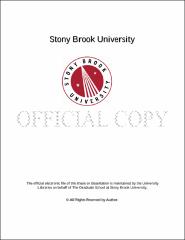| dc.identifier.uri | http://hdl.handle.net/11401/76529 | |
| dc.description.sponsorship | This work is sponsored by the Stony Brook University Graduate School in compliance with the requirements for completion of degree. | en_US |
| dc.format | Monograph | |
| dc.format.medium | Electronic Resource | en_US |
| dc.language.iso | en_US | |
| dc.publisher | The Graduate School, Stony Brook University: Stony Brook, NY. | |
| dc.type | Dissertation | |
| dcterms.abstract | Acute myeloid leukemia (AML) is a hematologic malignancy with a 5-year survival rate of less than 30%. We recently identified the bromodomain and extraterminal (BET) protein Brd4 as a therapeutic target in AML, and several trials are currently evaluating the clinical utility of BET inhibitors for this disease. BET inhibitors displace Brd4 from chromatin and subsequently reduce the expression of key oncogenes, such as Myc, leading to AML blast differentiation and cell death. However, the mechanism by which Brd4 maintains oncogene expression in AML is still unclear. We hypothesized that Brd4 functions by working with other coactivators in AML to promote expression of oncogenes. Brd4 is capable of associating with the Mediator complex, but the relevance of this interaction to the therapeutic effects of BET inhibition has not been explored. Here, we show that the BET inhibitor JQ1 causes the rapid release of Mediator from specific cis elements in the genome of AML cells. This effect occurs with greatest severity at a distal Myc super-enhancer, however JQ1 does not alter Mediator occupancy at all super- enhancers in the genome. Nonetheless, the degree of Mediator eviction provides a reliable correlate with JQ1- induced transcriptional suppression, a relationship that may have utility as a mechanism-based biomarker. Genetic knockdown of several Mediator subunits in AML cells, including Med12 and Med23, led to proliferation arrest, myeloid differentiation, and suppression of Brd4, Myb, and Myc target gene signatures. These findings unify Brd4 and Mediator functions within a common gene regulatory pathway that sustains the pathogenesis of AML. | |
| dcterms.available | 2017-09-20T16:50:34Z | |
| dcterms.contributor | Vakoc, Christopher R | en_US |
| dcterms.contributor | Tuveson, David A | en_US |
| dcterms.contributor | Krainer, Adrian R | en_US |
| dcterms.contributor | Zhang, Lingbo | en_US |
| dcterms.contributor | Stenlund, Arne. | en_US |
| dcterms.creator | Bhagwat, Anand Shripad | |
| dcterms.dateAccepted | 2017-09-20T16:50:34Z | |
| dcterms.dateSubmitted | 2017-09-20T16:50:34Z | |
| dcterms.description | Department of Molecular Genetics and Microbiology | en_US |
| dcterms.extent | 229 pg. | en_US |
| dcterms.format | Application/PDF | en_US |
| dcterms.format | Monograph | |
| dcterms.identifier | http://hdl.handle.net/11401/76529 | |
| dcterms.issued | 2016-12-01 | |
| dcterms.language | en_US | |
| dcterms.provenance | Made available in DSpace on 2017-09-20T16:50:34Z (GMT). No. of bitstreams: 1
Bhagwat_grad.sunysb_0771E_12713.pdf: 62455769 bytes, checksum: 3fb997ef2c95e45c707c865601162fed (MD5)
Previous issue date: 1 | en |
| dcterms.publisher | The Graduate School, Stony Brook University: Stony Brook, NY. | |
| dcterms.subject | Molecular biology -- Genetics -- Biology | |
| dcterms.title | BET Inhibition Releases the Mediator Complex from Specific cis Elements in Acute Myeloid Leukemia Cells | |
| dcterms.type | Dissertation | |

